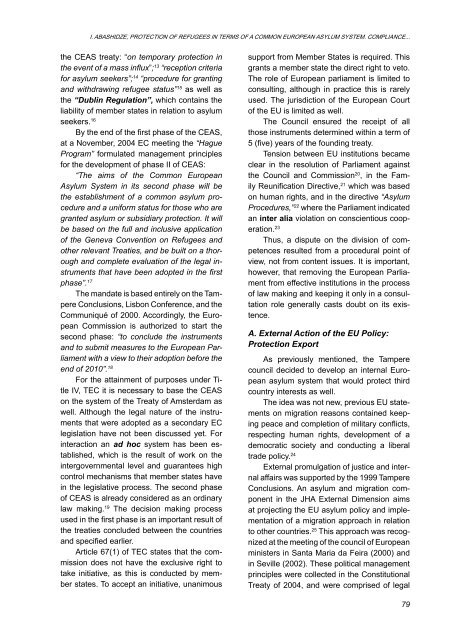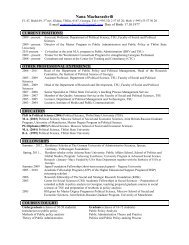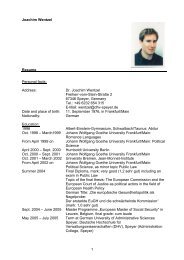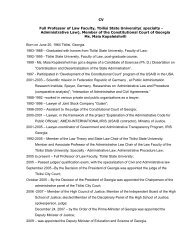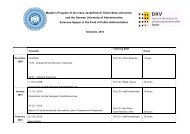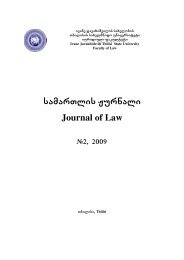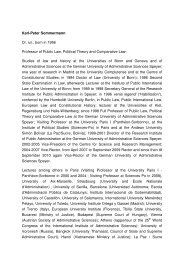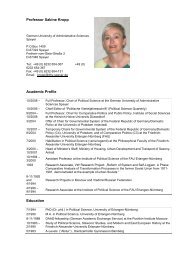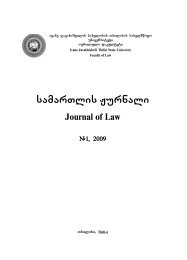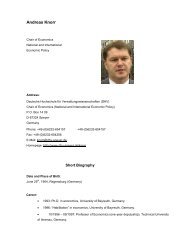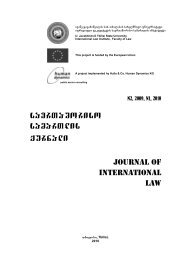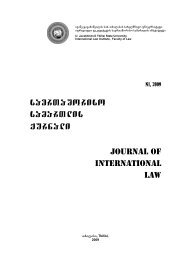Journal International Law_N2-10.indd
Journal International Law_N2-10.indd
Journal International Law_N2-10.indd
Create successful ePaper yourself
Turn your PDF publications into a flip-book with our unique Google optimized e-Paper software.
I. ABASHIDZE, PROTECTION OF REFUGEES IN TERMS OF A COMMON EUROPEAN ASYLUM SYSTEM. COMPLIANCE...the CEAS treaty: “on temporary protection inthe event of a mass infl ux”; 13 “reception criteriafor asylum seekers”; 14 “procedure for grantingand withdrawing refugee status” 15 as well asthe “Dublin Regulation”, which contains theliability of member states in relation to asylumseekers. 16By the end of the fi rst phase of the CEAS,at a November, 2004 EC meeting the “HagueProgram” formulated management principlesfor the development of phase II of CEAS:“The aims of the Common EuropeanAsylum System in its second phase will bethe establishment of a common asylum procedureand a uniform status for those who aregranted asylum or subsidiary protection. It willbe based on the full and inclusive applicationof the Geneva Convention on Refugees andother relevant Treaties, and be built on a thoroughand complete evaluation of the legal instrumentsthat have been adopted in the fi rstphase”. 17The mandate is based entirely on the TampereConclusions, Lisbon Conference, and theCommuniqué of 2000. Accordingly, the EuropeanCommission is authorized to start thesecond phase: “to conclude the instrumentsand to submit measures to the European Parliamentwith a view to their adoption before theend of 2010”. 18For the attainment of purposes under TitleIV, TEC it is necessary to base the CEASon the system of the Treaty of Amsterdam aswell. Although the legal nature of the instrumentsthat were adopted as a secondary EClegislation have not been discussed yet. Forinteraction an ad hoc system has been established,which is the result of work on theintergovernmental level and guarantees highcontrol mechanisms that member states havein the legislative process. The second phaseof CEAS is already considered as an ordinarylaw making. 19 The decision making processused in the fi rst phase is an important result ofthe treaties concluded between the countriesand specifi ed earlier.Article 67(1) of TEC states that the commissiondoes not have the exclusive right totake initiative, as this is conducted by memberstates. To accept an initiative, unanimoussupport from Member States is required. Thisgrants a member state the direct right to veto.The role of European parliament is limited toconsulting, although in practice this is rarelyused. The jurisdiction of the European Courtof the EU is limited as well.The Council ensured the receipt of allthose instruments determined within a term of5 (fi ve) years of the founding treaty.Tension between EU institutions becameclear in the resolution of Parliament againstthe Council and Commission 20 , in the FamilyReunifi cation Directive, 21 which was basedon human rights, and in the directive “AsylumProcedures,” 22 where the Parliament indicatedan inter alia violation on conscientious cooperation.23Thus, a dispute on the division of competencesresulted from a procedural point ofview, not from content issues. It is important,however, that removing the European Parliamentfrom effective institutions in the processof law making and keeping it only in a consultationrole generally casts doubt on its existence.A. External Action of the EU Policy:Protection ExportAs previously mentioned, the Tamperecouncil decided to develop an internal Europeanasylum system that would protect thirdcountry interests as well.The idea was not new, previous EU statementson migration reasons contained keepingpeace and completion of military confl icts,respecting human rights, development of ademocratic society and conducting a liberaltrade policy. 24External promulgation of justice and internalaffairs was supported by the 1999 TampereConclusions. An asylum and migration componentin the JHA External Dimension aimsat projecting the EU asylum policy and implementationof a migration approach in relationto other countries. 25 This approach was recognizedat the meeting of the council of Europeanministers in Santa Maria da Feira (2000) andin Seville (2002). These political managementprinciples were collected in the ConstitutionalTreaty of 2004, and were comprised of legal79


